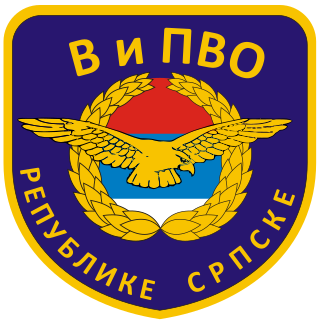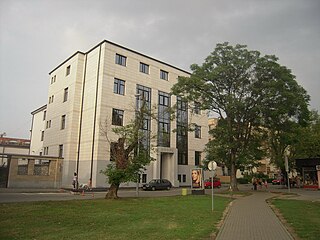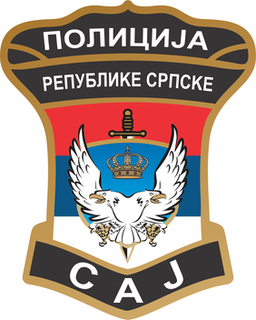The Army of Republika Srpska, commonly referred to in English as the Bosnian Serb Army, was the military of Republika Srpska (RS), the self-proclaimed Serb secessionist republic, a territory within the newly independent Bosnia and Herzegovina, which it defied. Active during the Bosnian War (1992–95), it continued to exist as the armed forces of RS, one of two entities making up Bosnia and Herzegovina, until 2006 when it was integrated into the Armed Forces of Bosnia and Herzegovina. Forces of the VRS engaged in a number of campaigns including Operation Corridor 92, Operation Vrbas '92, Operation Bura, Operation Spider and the army also perpetrated the siege of Sarajevo from 1992 to 1995 and the Srebrenica massacre in 1995.

Republika Srpska is one of the two entities of Bosnia and Herzegovina, the other being the Federation of Bosnia and Herzegovina. It is located in the north and east of the country. Its largest city and administrative centre is Banja Luka, lying on the Vrbas river.

Banja Luka or Banjaluka is the second largest city in Bosnia and Herzegovina and the largest city of Republika Srpska. Banja Luka is also de facto capital of this entity. It is the traditional centre of the densely-forested Bosanska Krajina region of northwestern Bosnia. According to the 2013 census, the city proper has a population of 138,963, while its administrative area comprises a total of 185,042 inhabitants.

Fudbalski klub Borac Banja Luka is a professional association football club, based in the city of Banja Luka, Bosnia and Herzegovina, and it is the major part of the Borac Banja Luka Sports Society. Borac Banja Luka is the most successful club in Republika Srpska, and one of the most popular football clubs in Bosnia and Herzegovina. The name Borac means "Fighter".

The Football Association of Yugoslavia (FSJ) was the governing body of football in Yugoslavia, based in Belgrade, with a major administrative branch in Zagreb.

Banja Luka International Airport, also known as Mahovljani Airport, after the nearby village of the same name, is an airport located 18 km (11 mi) north northeast of the railway station in the city of Banja Luka, the second largest city in Bosnia and Herzegovina. The airport is managed by the government-owned company "Aerodromi Republike Srpske".
Miodrag B. Protić was a Serbian painter, art critic, theorist and historian of art of the 20th century.

The University of Banja Luka is the second-oldest university in Bosnia and Herzegovina. A public university, it is the flagship institution of higher education in Republika Srpska, one of two entities of Bosnia and Herzegovina. As of 2018–19 school year, there are 11,186 enrolled students.

The Republika Srpska air force was the air force of Republika Srpska and was used primarily during the Bosnian war. In 2005, it was integrated into the Armed Forces of Bosnia and Herzegovina. SFOR still plays a large role in Bosnia and Herzegovina, which consists of the Federation of Bosnia and Herzegovina and Republika Srpska. Under the leadership of one president, the ministry of defense of both entities merged into one single ministry of defense with one chief of joint staff commanding both Air Forces. In 2004 there was again a restructuring of the armed forces, bringing the number of Air Force personnel down to 4,000. Next to the command, the 1st Regiment V i PVO consists out of a platoon, a radar battalion, artillery rocket ADF battalion, AF logistics battalion and aviation assets, a Fighter Bomber Squadron and Mixed Helicopter Squadron. In 2006 the Air Force of Republika Srpska was disbanded.
The 1992–93 First League of FR Yugoslavia was the first football season in the Federal Republic of Yugoslavia which was composed of the republics of Serbia and Montenegro, following the breakup of the SFR Yugoslavia. FK Partizan were the champions.

Police of Republika Srpska is the executive and operative agency of the Ministry of Interior of Republika Srpska. It is headquartered in Banja Luka. The mission of the police is the protection of the Constitution of Republika Srpska, security, protection of citizens, and their rights.

The Academy of Sciences and Arts of the Republika Srpska is highest representative institution in the Republika Srpska of science and art founded in 1996. It has four departments – Department of Social Sciences, Department of Literature and Arts, Department of Natural, Mathematical and Technical Sciences and the Department of Medical Sciences. It is based in Banja Luka.

Starčevica is a neighborhood and a local community in Banja Luka, Republika Srpska, Bosnia and Hercegovina. It is located on the right bank of the river Vrbas, southeast of the city center.

Stefan Marinović, also known as Stefan of Scutari was a 16th-century Serb printer from Scutari (Shkodër). Marinović printed his books first in Venice and then in Scutari. He always emphasized that he was from Scutari.

The Archives of Republika Srpska is an administrative organisation within the Ministry of Education and Culture of Republika Srpska, one of two constituent entities of Bosnia and Herzegovina. The Archives' headquarters is in Banja Luka, and it has its regional offices in Doboj, Zvornik, Foča, Sokolac, and Trebinje. Its aim is to collect, store, preserve, organise, research, and provide access to archival materials on the territory of Republika Srpska, where it is designated as a central institution for the protection of cultural heritage. The Archives is also involved in research projects, exhibitions, and in the publishing of books and scholarly papers, mostly in the fields of archival science, history, and law. It is organised into two sectors, which are responsible for the protection of archival materials within and outside the Archives, respectively. The Archives currently holds 794 fonds and 35 collections, which span the period from the 17th century to the modern day.

The Special Anti-Terrorist Unit of Ministry of Interior of Republika Srpska is a special police unit of the Police of Republika Srpska, one of two autonomous entities that comprise Bosnia and Herzegovina.

2nd Krajina Brigade was infantry brigade of the Army of Republika Srpska and Yugoslav People's Army founded on 1991 in Rakovačke bare settlement, Banja Luka.

Milan Blagojević in Gračanica is a Serbian jurist, a full-time Professor of Constitutional Law and the former judge of the District Court of Banja Luka.

Palace of the Republic is official residence of the President of Republika Srpska.

1st Krajina Corps was one of the seven corps of the Army of Republika Srpska (VRS). Before implementation into the Army of Republika Srpska the corps was known as 5th Corps of Yugoslav People's Army or Banja Luka Corps. Because of this fact it was successor of the infrastructure, organization and most of the equipment. Main task of the corps was to defend western parts of Republika Srpska, today these area is mostly part of Banja Luka region. It was most numbered corps of VRS with between 51.000 and 60.000 soldiers. During the War in Bosnia and Herzegovina 6.997 died, 27.176 wounded and 1.031 soldiers are missing.


















